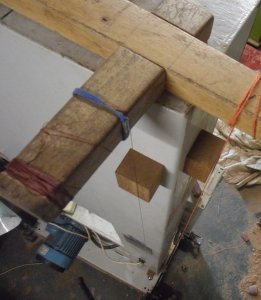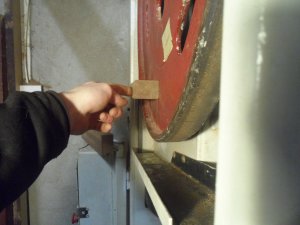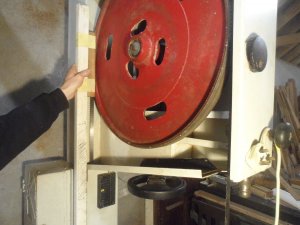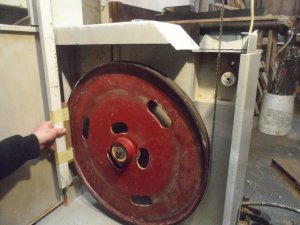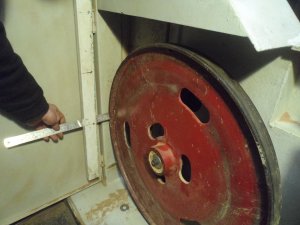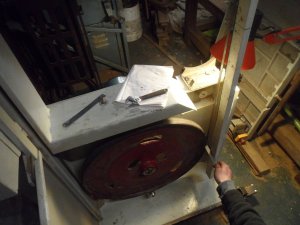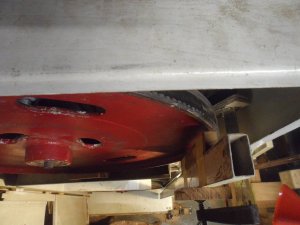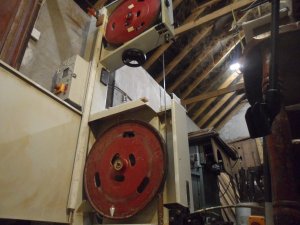Hi All,
New member hoping to get some guidance on a newly purchased BS350S.
It arrived a week ago and I have spent the last week (on and off) setting it up.
I have been struggling to get everything square and just wanted to know if 'they are all like that' or if I have a Friday afternoon machine.
I couldn't get a good straight edge with the supplied blade (10mm) and as I bought the 3 blade RP pack with the machine I fitted the 19mm blade. I was able to square the table/guide etc to the blade by adjusting the trunnion a fair bit but that left the blade resting against the right hand upper guide (that was adjusted as far back as possible). I also struggled to get enough tension on the blade. I have since read various posts suggesting the BS350S can't really cope with the 19mm blade. However it did run and cut well, but made some strange noises, I couldn't work out what was causing it so refitted the 10mm supplied blade.
The blade when fitted was resting against the insert cut out, so adjustment of the trunnion again has centred it. However the blade is close to the upper right hand guide and I can't find a way of moving/aligning the guide carrier to give some adjustment.
Things I have learnt reading this forum and which answered many of my questions;
Buy SuperTuff blades
Don't attempt to use a 19mm blade on the BS350S
They all need some fettling from the outset
If anybody is able to advise based on their experience my remaining questions are;
1, I expected to have to setup/align the machine, but is it normal to need to completely redo this each time a blade is changed ?
2, The insert in the table sits 1 or 2mm below the surface of the table so wood is catching as I try to cut it (I need to ease the leading edge up over the lip), is this normal ?
3, The general alignment seems a bit out, as mentioned above looking at the machine the blade sits to the right of the 'upright' and is on/very near the right hand upper guide. The lower guides are almost perfect with the blade resting between the guides evenly.
RP support have been great, but I am still awaiting a call back on a solution to the alignment of the blade/upper guides.
Really just wondering if I have a problem machine or if this is typical.
New member hoping to get some guidance on a newly purchased BS350S.
It arrived a week ago and I have spent the last week (on and off) setting it up.
I have been struggling to get everything square and just wanted to know if 'they are all like that' or if I have a Friday afternoon machine.
I couldn't get a good straight edge with the supplied blade (10mm) and as I bought the 3 blade RP pack with the machine I fitted the 19mm blade. I was able to square the table/guide etc to the blade by adjusting the trunnion a fair bit but that left the blade resting against the right hand upper guide (that was adjusted as far back as possible). I also struggled to get enough tension on the blade. I have since read various posts suggesting the BS350S can't really cope with the 19mm blade. However it did run and cut well, but made some strange noises, I couldn't work out what was causing it so refitted the 10mm supplied blade.
The blade when fitted was resting against the insert cut out, so adjustment of the trunnion again has centred it. However the blade is close to the upper right hand guide and I can't find a way of moving/aligning the guide carrier to give some adjustment.
Things I have learnt reading this forum and which answered many of my questions;
Buy SuperTuff blades
Don't attempt to use a 19mm blade on the BS350S
They all need some fettling from the outset
If anybody is able to advise based on their experience my remaining questions are;
1, I expected to have to setup/align the machine, but is it normal to need to completely redo this each time a blade is changed ?
2, The insert in the table sits 1 or 2mm below the surface of the table so wood is catching as I try to cut it (I need to ease the leading edge up over the lip), is this normal ?
3, The general alignment seems a bit out, as mentioned above looking at the machine the blade sits to the right of the 'upright' and is on/very near the right hand upper guide. The lower guides are almost perfect with the blade resting between the guides evenly.
RP support have been great, but I am still awaiting a call back on a solution to the alignment of the blade/upper guides.
Really just wondering if I have a problem machine or if this is typical.




